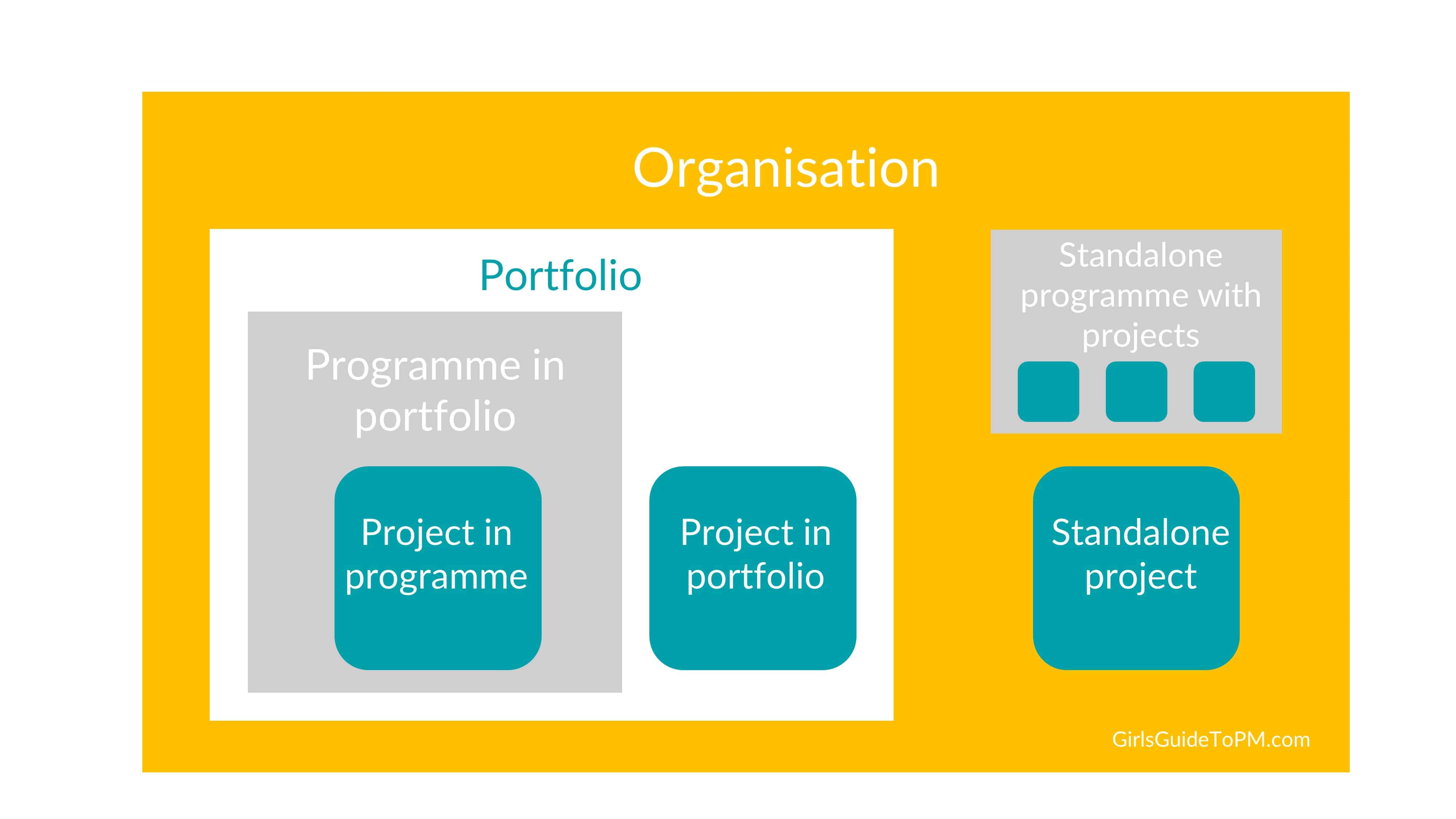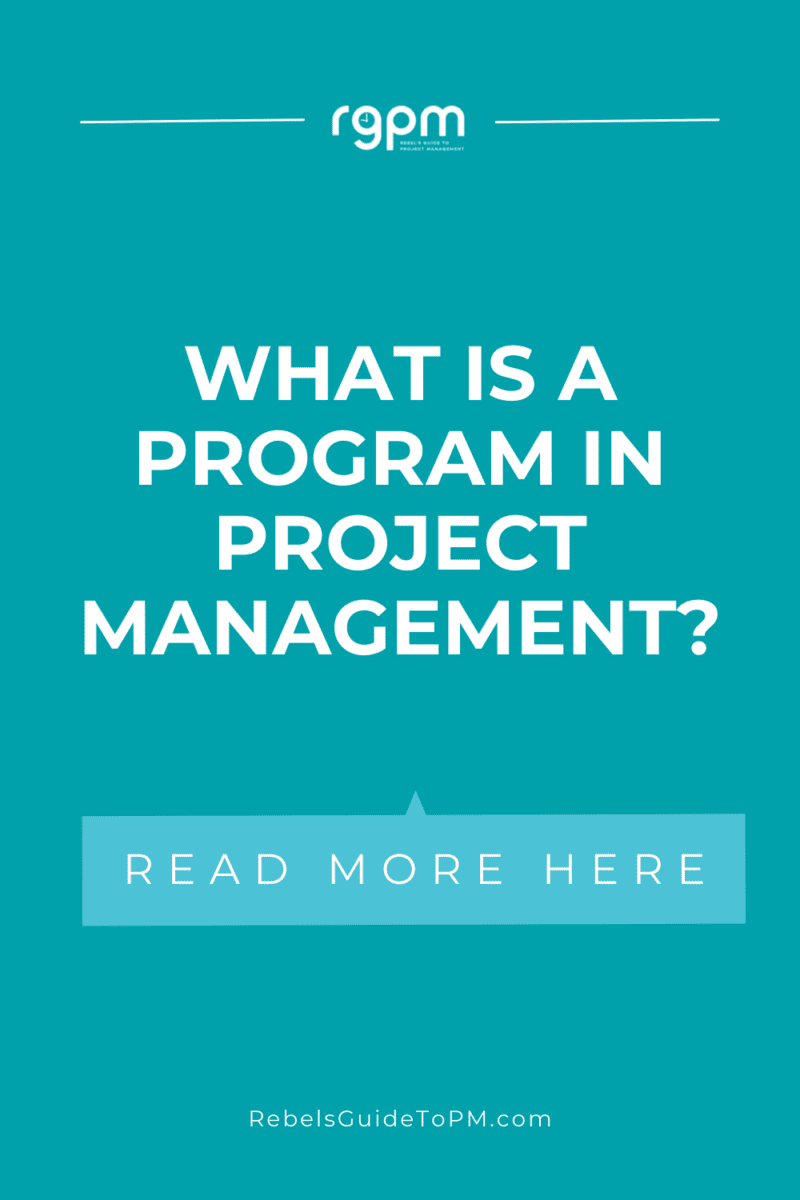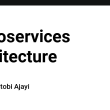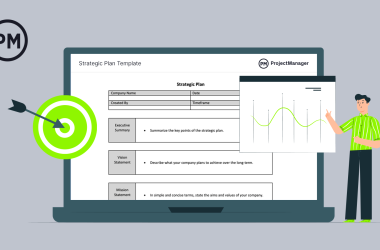Wondering what a progam is, and how it’s different to a project, and why some leaders in your team manage programs and projects, and some only manage projects?
I’ve been program managing on and off for a good chunk of my career. While my official current job title is Senior Project Manager, I led a program in my last job and have led programs in this role.
I’m also the author of Managing Multiple Projects, which is a book about juggling all the things at work — and program management skills will definitely help you there!
You might be thinking of stepping into a program management role, or want to know how a program works in practice and whether it makes sense for you to start to organize your projects in that way.
That’s what we’ll be looking at in this article. You’ll learn what a program is, why it’s worth organizing work into programs, projects vs programs and how they differ, and the different types of programs you might find in your organization.
Plus, at the end, I have some further reading recommendations for you of the best program management books from the ones I have read.

The definition of a program
What is a program in project management terms? Here’s a definition.
A temporary structure designed to lead multiple interrelated projects and other work in order to progressively achieve outcomes of benefit for one or more organizations..
Managing Successful Programmes (5th Ed), PMI
The Praxis Framework defines it like this:
A collection of projects managed in a co-ordinated way to create benefits for the host organisation.
Praxis Framework
In other words, it’s a collection of related projects AND BAU activity that together deliver substantive change that cannot be achieved through a single project.
Whichever you think is the best description of program management, all the professional bodies will use similar language to describe grouping projects together for the purpose of delivering something bigger.
And that brings us on to the purpose.
What’s the point of a program in project management?
The purpose of a program is to tie together related work in a way that makes it easier to deliver a strategic goal.
If you work on a program, either as a project manager, or in a program office role (or as the program manager) you’ll know that the goal is that your work contributes to the organization’s strategic objectives.
Program and project management makes it easier to manage resources and expenses because you can juggle priorities and manage multiple projects.
As long as you know where you want to get to overall, you can broadly make sure that you achieve that with the resources and budget that you have.
Project vs Program Management
Project management delivers a single output. Program management delivers a business goal via a collection of projects.
Programs can be transformative, although large projects can be too.
I have done both. As a program manager, I ran a collection of related projects with the goal of delivering improvements across the business on a large scale.
As a project manager, I ran complex projects with plenty of workstreams, but there was only one objective and one output.
For example:
Program: Digitize all our processes — this is a large scale goal that would involve many teams and many projects to achieve.
Project: Migrate the accounting software to a new tool — this might be a complex project that affects many staff, with serious implications for process re-engineering and training, but it’s just one initiative.
Differences between project and program management
| Project | Program |
| Delivers a single output | Delivers a business outcome |
| Has shorter term goals | Runs for a longer period of time to deliver strategic goals |
| Run by a project manager | Run by a program manager, often with support from PMO, Finance and business leadership |
| Scope tends to be defined | Scope can vary over the duration to better address business goals |
| Managed tactically to deliver on time, on budget | Managed strategically to ensure resource capacity and with project interdependencies in mind |
The key everyday difference for us as project professionals between project and program management is the work that you do every day. A project manager keeps the project moving forward, unblocking issues and focusing on schedule, quality, deliverables and everything else.
The work of a program manager
A program manager oversees the work of several project managers, ensuring the program overall is balanced and has a coordinated approach to risk management, resource management and budgeting.
You’ll be liaising with executive management and building relationships with project managers, looking at the larger strategy, liaising up to the portfolio management team, looking at business processes and cost control.
I have a detailed guide on what it takes to be a great program manager, so go ahead and read that next if you want more details on the role.
Program structure
First, let’s look at how programs fit into the project/program/portfolio way of looking at work.
Programs are collections of projects and BAU work that together will deliver an overall goal. Programs can be part of a portfolio or standalone. They can include a couple of projects or lots.
The picture below explains the program structure, with regards to how it fits into the rest of the project management

Within a portfolio of projects in the organization, you’ll have some that are managed as a program and others that standalone.
A project sponsor will head up a project; you might have a senior business leader as the program sponsor.
Different types of program
Did you know that there are three types of program? Yes, there are! They are:
- Visionary programs
- Emerging programs
- Mandatory programs.
They are all valuable, but each has particular quirks which change how the team works and how they are managed. Let’s look at each of those in turn.
1. Visionary programs
“I have a vision…”
A vision-led program is where the senior leaders have a specific idea of what they want the organization to look like when the work is complete.
These tend to be transformative programs, delivering organizational or cultural change such as a restructure or fundamentally changing the operating principles of the business (going paperless, for example). There might be an element of product management involved too.
In this type of program you’ve got senior leadership support – and while it may sound obvious to say that, oftentimes you don’t have the sponsorship required in project management, so it’s a good thing that it is present here. It’s very much a top-down approach.
How these programs start
Management will have come up with an idea of the future state of the business in a strategy session, and the program is the practical way of getting there.
There will be a number of projects required to achieve the goals in the strategic plan, so you could find yourself working on one of the projects delivering a component part, or in the program office itself managing the overall delivery.
There’s a strong commitment to the vision and what it will do for the company, and you’ll find that everyone gets behind it (or at least, most people) because they see that they have no choice: the company is changing anyway.
This makes the change relatively easy to handle but does mean the program team have to spend more time looking for people who are going to adversely affect the program but aren’t prepared to say so out loud for fear of appearing not to be committed to the upcoming changes.
While it helps in many ways to have such overt senior support, it does push resistance to change underground!
Read more about the role of change management on projects and programs.
2. Emerging programs
This is perhaps the hardest type of program to get involved with: programs that don’t start as programs but that grow into one by default.
It happens because the business kicks off a number of projects that are loosely connected. Over time, people realize that they are struggling to secure similar resources and that there is an overlap with some outputs or deliverables.
There may even be concern that benefits are double-counted. As a result, a program framework emerges so that everything can be brought together under a single leadership structure, with better coordination and communication.

One of the challenges with this type of program is finding ways to align the projects. It starts with having decent project scheduling software because then at least you can see what each individual project is doing and when.
Then you can start to pull together resource schedules, dependencies and costs to create a common structure. It is possible to do this, but it takes work and oversight, and it isn’t easy!
Issues with emerging programs
The trouble with trying to overlay program management approaches on to a collection of related projects is that you will be trying to standardize working practices and reporting lines across a number of projects where those approaches are already in play.
You’re trying to change the way people work, and to a certain extent, the freedom of operation that they used to have. That can create resistance from the project leadership teams, so the focus for the program manager here should be on bringing people together to see the benefit of working as a program team.
If you can highlight the benefits (access to shared resources, less rework etc) then hopefully you can build a strong program team from the bottom up. Otherwise, this guide to how to recover a troubled program might help!
One way to do this is to use an organization chart to define roles within the program. Get a free org chart template here.
3. Mandatory programs
Finally, you’ve got mandatory programs of work. There is nearly always something that falls into this category happening at any given time because we’re managing programs in a changing world.
For example, new legislation might generate four or five different things that the business needs to be aware of.
These could be separate projects, but because the legal resources and budget are held centrally it’s easier to manage those projects as a program to monitor the overall position for the company’s compliance.
An example of a mandatory program would be GDPR. Businesses needed to implement changes across HR, records management, IT, Marketing and Customer Services – and probably more.
The outcomes of projects in mandatory programs are likely to be new policies, updating terms and conditions, implementing process changes to comply with regulation and similar.
You are unlikely to be launching new products – these projects are all about keeping the company compliant with trading rules and ensuring you all stay in a job. That makes them interesting, and also as the organization has to do them, generates a fair amount of buy in that makes it easier to get things done.
Next steps for the aspiring program manager
Program management is the next natural step for many people after a career in project management.
Read my guide to the role of program manager to see if it’s something you’d like to do.
Program management is a useful addition to the organization (although be aware for it to be considered a bit of a bureaucratic overhead for some stakeholders).
If you’re thinking of setting up a program management approach within your organization, go for it! You’ll quickly be able to see if it is adding value by allowing your teams to collaborate more effectively together, manage resources more efficiently and get closer to your strategic objectives.
Quick answers
What’s the difference between a project and a program?
What’s the difference between a program and a project manager?
Book Recommendations for Program Management
- APM Introduction to Programme Management
- Program Management. Here’s my review of Michel Thiry’s book.
- MSP Survival Guide to Programme Managers (MSP is the framework I use for program management)
- Managing Successful Programmes (this one is my go to guide)
This article first appeared at Rebel’s Guide to Project Management






